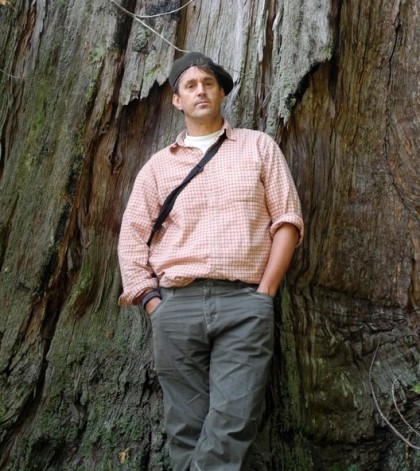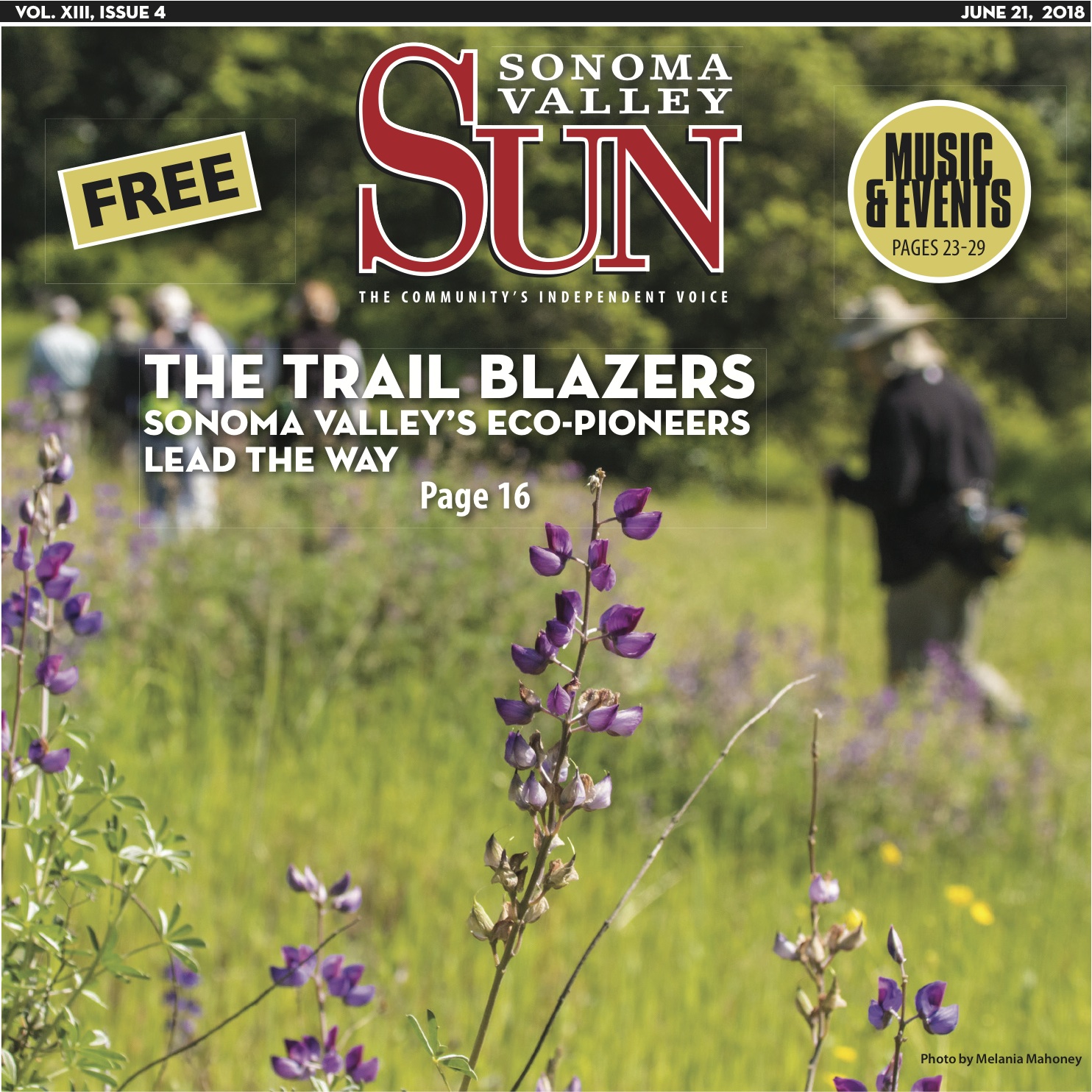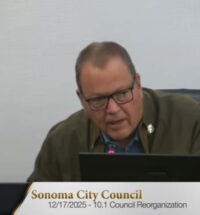By Jonah Raskin
Last October’s firestorms stunned Sonoma Valley citizens, though once the smoke cleared and embers were extinguished, families and friends ventured out to see the spectacle of blooming flowers and green trees.
Richard Dale, the executive director for 26 years at the Sonoma Ecology Center (SEC), said that the disaster brought about “heightened interest in the environment.” Some of that concern, he added, was “about the need to prevent future fires” and some was “amazement at the natural world.”

In light of our recent fires, and droughts and floods, it might be useful to remember that the pioneers who crossed the plains, forded rivers and scaled mountains were the opposite of conservationists. In fact, they made a continental-sized mess by slashing forests, exhausting soils, polluting waters, exterminating Indians tribes and decimating wild life.
When thousands of wanna-get-rich-quick folk prospected for gold in California, they polluted San Francisco Bay with mercury. Ever since then, the Golden State has been a land defined by both boom and bust.
In the mid-nineteenth-century, “naturalists” sounded an alarm that still echoes today. Ralph Waldo Emerson brought the gospel of Nature to the nation. Henry David Thoreau, one of the first real eco-pioneers, praised the simple, sustainable life, and Mary Austin, a friend of Jack London’s, wrote a classic about the California desert, The Land of Little Rain.
A national park rose up at Yosemite thanks to John Muir, the roving Scotsman who exclaimed, “Save the Trees,” a cry heard these days from Marin County’s Muir Woods to Sonoma’s Sugarloaf Ridge State Park and far beyond.
Over the last 100 years, names and terms have changed in the environmental movement, especially after Earth Day was born in 1970 and helped jumpstart the SEC. Still, many underlying concerns are much the same as they were when Jack London joined the back-to-the-land movement in 1905 and farmed organically at Beauty Ranch.
For those unfamiliar with the word “ecology,” it might be helpful to say that it comes from the ancient Greeks who thought of the Earth as a house that ought to be neat and clean. Not surprisingly, Gary Snyder’s Earth House Hold has found fans among local environmentalists who call for “biodiversity,” not one big vineyard.
Today, there’s more urgency about the Earth than ever before. The waters in San Pablo Bay and elsewhere are rising. Cities, such as San Francisco, are sinking. Ground water tables are falling from the Central Valley to Sonoma Valley. Temperatures are going up— Sonoma grape growers and meteorologists report— and there’s no escape from greenhouse gasses.
As SEC’s Dale said, “we’re doing fantastic work, but the environment is unraveling as fast as we’re holding it together. It’s not nearly as healthy as we’d like it to be.” Fortunately, Sonoma County has an exuberant cast of savvy eco-pioneers. Indeed, there’s an embarrassment of riches in the local environmental movement.

Dale and SEC’s lead biologist, Caitlin Cornwall, have designed a program meant to bring resiliency to people and nature. Teri Shore at Greenbelt Alliance keeps an eye on commercial-development and emphasizes “smart growth” not sprawl.

Craig Anderson at Landpaths takes hikers on trails across Sonoma Mountain, the single-most iconic landscape in the county, fortunately spared much of last October’s firestorms. “When you stand on the North Slope of Sonoma Mountain and look below, you see the whole county spread out,” Anderson said. “You grasp your home and nearly everything that comprises it.”
Sonoma’s eco-pioneers aren’t isolated. They’re sustained by organizations such as the Sonoma County Agricultural Preservation and Open Space District—which is funded by tax dollars—Bouverie Preserve, Sonoma County Regional Parks, The Sonoma Land Trust and Jack London State Historic Park, a destination for backpackers, hikers, and bird watchers. Executive director, Tjiska Van Wyck, and dozens of volunteers have instilled new life in the old park.

SSU professor, Greg Sarris, the tribal chairman of the Federated Indians of Graton Rancheria, has revived Indian legends in books like “How A Mountain Was Made”. Local historian Arthur Dawson—who lost his Glen Ellen house in the fire—has exhumed the Sonoma Valley past and told stories about the early settlers and the Native Americans who tended the landscape, and who would laud the current crop of environmentalists who have created wildlife corridors so that deer, bobcats and more can wander without becoming road kill.
Tony Nelson, the Sonoma Valley Program Manager at the Land Trust, said that the corridors are more important now than ever before because the landscape is increasingly “fragmented.” He added that, “projected changes in climate, will bring changes in habitat. Animals are expected to move with them.” Fortunately, they’re getting help not only from the Land Trust, but also from private individuals who are stewards of the land. Mike Benziger cultivates pot biodynamically and cares for the environment at Glentucky Family Farm on Sonoma Mountain.
Bob Cannard at Green String on Adobe Road supplies Alice Waters’ Chez Panisse with spectacular produce and adheres to ecological principles. Paul Wirtz on Arnold Drive grows beautiful, bountiful crops that are sold at Friday’s market and help feed and nourish the community. Phil Coturri and his sons manage vineyards organically, and make organic reds and whites at Winery Sixteen 600. Their tasting room links culture and agriculture.
The environmental community has also had to clean up the mess made by previous generations. For much of the twentieth century, Sonoma ranchers sucked so much water from Sonoma Creek that steelhead became nearly extinct and the waters polluted. In 1971, Bill Lynch, then a young journalist, published “The Obituary of a Trout Stream.” He urged readers to “take a good close look at Sonoma Creek.” What they would see, he wrote, were “beer cans, wire, bottles, old tires and wrecked cars scattered on the banks or protruding through the yellow scum on the stagnant water.”
Still, there were visionaries in Sonoma even before Earth Day spurred the growth of the local environmental movement. Otto and Ann Teller at Oak Hill Farm, and neighbors like Pat and Ted Eliot, helped pave the way for twenty-first-century eco-pioneers by insisting that mansions not deface the landscape.
Today, it’s harder for citizens to honestly exclaim, “It’s all good.” Even the survivors of last fall’s firestorms who boasted “Sonoma Strong” have recognized that the task of rebuilding is more challenging than originally thought.
But such is the allure of this place that many homeowners who were burned out and who fled, have returned and are starting anew with an eye on resilience and sustainability.
Newcomers to Sonoma Valley learn what many longtime residents have known for ages. One recent arrival noted that, “It talks time, money, work, imagination and the whole community to protect land, woods and water.”
Eight years ago, when the State of California wanted to close its spectacular 3,900-acre state park in Kenwood, SEC’s Dale called for the creation of “Team Sugarloaf.” Ever since then, five organizations, including SEC, have worked together to greatly expand the number of visitors and volunteers and to improve habitat, trails and campgrounds.
“Team Sugarloaf has been a booming success,” SEC’s Cornwall said.
The continuing challenge is to resist the NIMBY impulse, liberate people from their own backyards, and persuade them to build alliances. Foodies, farmers, wine lovers and ecologists might join hands more often than they do and learn to speak a common language.
Jonah Raskin is the author of “Field Days: A Year of Farming, Eating and Drinking Wine in California.”
Cover photo by Melania Mahoney






Be First to Comment